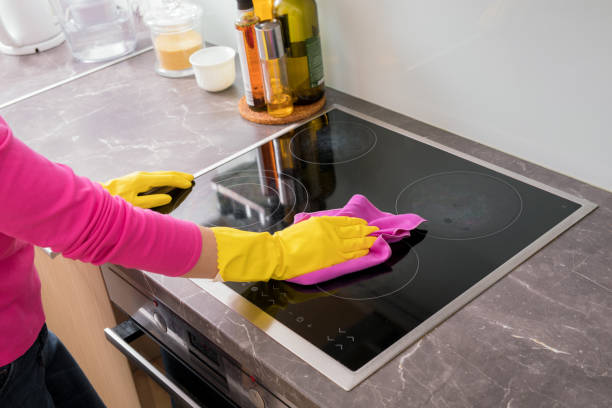Cleaning a stove top may seem like a daunting task, especially when dealing with tough stains and grease. In this article, we’ll walk you through the best methods to clean your stove top, ensuring it looks spotless and functions efficiently.
Gather Your Cleaning Supplies

The first step in cleaning your stove top is to gather all the necessary supplies. For a thorough clean, you will need a few key items. Begin with a soft cloth, dish soap, white vinegar, baking soda, and a non-abrasive scrubber. Ensuring you have these items on hand will make the cleaning process smooth and efficient.
Additionally, having a dedicated stove top cleaner can be beneficial for tackling particularly stubborn stains. You might also want to keep some microfiber cloths or paper towels nearby for drying and polishing the surface after cleaning. Proper preparation will make the task easier and more effective.
Cleaning Coil and Electric Stove Tops
Coil and electric stove tops have unique cleaning requirements. First, ensure the stove is completely cool before starting the cleaning process. Remove the coils and drip pans, if possible, to access the area beneath them. Start by wiping down the surface with a damp cloth to remove loose debris.
Mix a solution of warm water and dish soap, and use this to scrub the stove top. For stubborn stains, create a paste using baking soda and water, applying it to the stained areas and letting it sit for at least 15 minutes. Use a non-abrasive scrubber to gently work the paste into the stains before rinsing with a clean, damp cloth.
Cleaning Gas Stove Tops
Gas stove tops often have removable grates and burner caps that need to be cleaned separately. Start by removing these components and soaking them in hot, soapy water for about 15-20 minutes. While the parts are soaking, use a damp cloth to wipe down the stove top, clearing away any loose food particles and debris.
For tougher stains and grease buildup, use a mixture of equal parts vinegar and water. Spray this solution onto the affected areas and let it sit for several minutes. Use a non-abrasive scrubber to remove the stains, then rinse the stove top with a clean, damp cloth. Once the grates and burner caps are clean and dry, replace them on the stove.
Dealing with Stubborn Stains
Sometimes, grease and food spills can leave behind stubborn stains that require extra effort to remove. For these tough stains, create a paste using baking soda and water. Apply the paste to the stained areas and allow it to sit for 15 to 20 minutes. The baking soda will help loosen the grime, making it easier to scrub away.
After the paste has had time to work, use a non-abrasive scrubber to gently scrub the stains. Be sure to rinse the area thoroughly with a clean, damp cloth to remove any residue. If stains persist, repeat the process or consider using a commercial stovetop cleaner specifically designed for tough stains.
Polishing and Maintaining Your Stove Top
Once you’ve thoroughly cleaned your stove top, it’s essential to maintain its shine and cleanliness. After each use, wipe the surface with a damp cloth to prevent the buildup of food particles and stains. You can also use a microfiber cloth to buff the stove top, restoring its shine and preventing streaks.
Using a stove top cleaner regularly can help maintain the appliance’s pristine appearance. Follow the manufacturer’s instructions for the best results, and always test the cleaner on a small area first to ensure compatibility. Regular maintenance will keep your stove top looking great and extend its lifespan.
Conclusion
Cleaning your stove top, including tackling tough stains and grease, doesn’t have to be a challenging task. With the right supplies and techniques, you can ensure your stove top remains spotless and in excellent condition. Regular maintenance and quick cleanups after each use will prevent buildup and make the task more manageable. Happy cleaning!
FAQs
1. How often should I clean my stove top?
Ideally, you should wipe down your stove top after each use to prevent food and grease buildup. A more thorough cleaning, including scrubbing and dealing with tough stains, can be done once a week or as needed.
2. Can I use bleach to clean my stove top?
Bleach is generally not recommended for cleaning stove tops as it can damage the surface and is not food-safe. Stick to milder cleaners like dish soap, baking soda, and vinegar for effective and safer cleaning.
3. What can I use to clean stove burners?
For gas stove burners, soak the removable parts in hot, soapy water, then scrub with a non-abrasive scrubber. For electric coil burners, wipe them down with a damp cloth but avoid soaking them. Always ensure they are completely dry before reassembling.
4. How do I remove burnt-on food from my stove top?
Create a paste with baking soda and water, apply it to the burnt-on food, and let it sit for 15 minutes. Then, use a non-abrasive scrubber to gently scrub away the residue. Repeat if necessary until the food is removed.
5. Are commercial stove top cleaners more effective?
Commercial stove top cleaners can be very effective, especially for tough stains and grease. However, it’s essential to follow the manufacturer’s instructions and test the cleaner on a small area first to ensure it doesn’t damage the surface.
